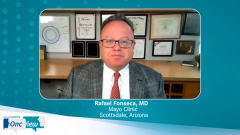
Quadruplet vs Triplet Regimens in Transplant-Eligible MM: Choosing the Optimal Frontline Regimen
Dr Rafael Fonseca, MD, provides insight on the evidence around quadruplet versus triplet therapies in patients with newly diagnosed, transplant-eligible multiple myeloma, and how to select the appropriate treatment regimen for this patient population.
Episodes in this series

Rafael Fonseca, MD: Hello and welcome to this Contemporary Cancer Network OncView Program titled Advances in Multiple Myeloma: Insights on Translating Evidence to Clinical Practice. I'm Rafael Fonseca. I'm a professor of medicine at the Mayo Clinic and the chief innovation officer at Mayo Clinic in Arizona. Let's get started.
For patients with newly diagnosed myeloma who are transplant-eligible, we are quickly moving to the use of 4-drug combinations. 3 drugs have remained the standard of care and the prototype for this has been the combination by the acronym RVd. Some centers use KRd. But the reality is we're very quickly incorporating that fourth drug which is an anti-CD38 monoclonal antibody and those are now being supported by the treatment guidelines in the United States.
At the 2021 ASH [American Society of Hematology] meeting, we heard an update provided by our colleague, Dr. Jacob Laubach [Boston, MA] on a 24-month update for the GRIFFIN trial and the results are consistent with what has been reported before but now with more mature information regarding progression-free survival. And what we see is that the 4-drug combination in the case of the GRIFFIN study there is a comparison between Dara-RVd versus RVd where you see clearly an improvement in the depth of the response both by classic criteria but also by the termination of MRD or minimal residual disease determination.
And we're seeing that good responses translate into durable disease control, and that's what we're seeing at 24 months update with significant improvements in progression-free survival. A very positive finding is that the vast majority of patients, as we go 3 and then out even into 4 years of projected will remain with the good disease control. So, this really provides a novel opportunity to have durable and safe control for multiple myeloma that is newly diagnosed, specifically in patients who are transplant-eligible.
As we consider the options that are available for patients with newly diagnosed transplant-ineligible myeloma, very quickly we're moving to the 4 drug combinations. If one were to ask the questions, what patients might have 3 drugs versus 4 drugs? I would say there's two factors right now that determine that. One is familiarity of the treatment doctorwith the regimens. To me, the scientific data is very clear that the results will be better with 4 drugs and the second one will be the evolving insurance coverage by payers for this combination. I think still sometimes requires some work by the treating physician and team on behalf of the patients so we can get approval for these regimens. But as we look at depth of response, MRD, durability of that response, there is no question that it's better for patients to receive the 4 drugs. Potentially, there could be a patient where the addition of something like Daratumumab might be not indicated because of intolerance a previous reaction but I would say the de-facto stance right now is that most patients would benefit from 4-drug combinations.
Transcripts edited for clarity.
Newsletter
Stay up to date on recent advances in the multidisciplinary approach to cancer.
















































































